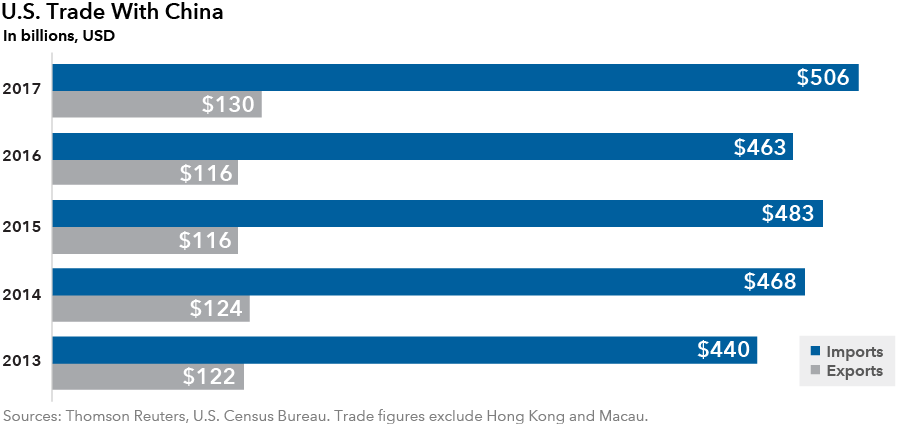Chart in Focus
Trade
Increased trade tensions between the U.S. and China — the world’s two biggest economies — are rippling through global markets, affecting a wide range of stocks, commodities and currencies. The U.S. has launched a series of tariffs and quotas aimed at curbing Chinese imports, including steel and aluminum, and China has responded in kind, targeting a long list of U.S. products. Together, the actions amount to multi-billions of dollars in punitive trade measures.
At this stage, the potential ramifications of the tariffs and corresponding impact on supply chains remain uncertain. Volatility is likely to persist as this trade dispute evolves.
In this Q&A, Capital Group Vice Chairman and portfolio manager Rob Lovelace shares his thoughts on trade negotiations and their impact on multinational companies.
With tax legislation behind us, the U.S. administration is focused on trade. Negotiations on tariffs and a potential trade war have markets nervous. What is your view on what we might see unfold, both in the near term and the long term?
Trade will continue to be on the forefront of the international agenda. U.S. and China leaders each have strategic economic goals, many of which do not align. This mismatch will lead to some tough negotiations.
President Trump has talked about his issues with trade deficits for decades. It features in many of his public comments throughout his business career. He has stated the U.S. needs better balance in trade accounts with all other countries. In line with this view, the administration wants a dramatically reduced trade deficit in physical goods. It remains unclear if they will also focus on services and financial trade which is not included in the traditional trade-deficit numbers they usually talk about. The current negotiations on tariffs with China should be viewed in that broader framework.
How do you see China approaching this and the U.S. responding to it?
China recently presented its development agenda. Its leaders have set specific goals for 2025 in areas in which they want the country to excel. The list is long, but the more important areas from our vantage point as investors include semiconductors, robotics, industrial and agricultural machinery, aerospace equipment, high-speed rail, biomedicine and electric vehicles. China’s stated goal is to have world-class companies in these sectors, and the unstated goal is to have independence from foreign suppliers.
In the internet space as well, U.S. companies such as Google have not been allowed to operate in China unless they limit access to certain content and cooperate with the government in other ways. These limitations on foreign companies created the space that helped propel Chinese companies such as Tencent and Alibaba, which are now among the most valuable technology companies in the world based on market capitalization. It is becoming clear that in these critical areas, China wants strong local champions, which reduces interdependence. They want a self-sustaining, more closed system. And with President Xi Jinping’s ascendancy as a leader unencumbered by term limits, China can more easily follow through on that long-term strategic vision.
For a trading system to survive and thrive over the long term, interdependence is critical. China wants inter-linkages in many of these areas, but not interdependence. It is different from how Japan and Germany evolved into economic giants in the post–World War II period, with economies designed for global interdependence and integration.
China has a much more mercantilist approach. In return for providing access to its huge market, China has assumed it can impose a host of restrictions on U.S. investment and trade. While it perennially objected, the U.S., Europe and others lived with these practices because China’s market offered increasing opportunities as it progressively opened up. There were also expectations that as China progressively opened wider its economy, those restrictions would fade.
Given China’s actions and goals, the U.S. is trying a different, more aggressive approach. It wants China to open its economy and integrate into the global system. It wants protection of intellectual property. If not, the U.S. has to be focused on how it builds systems that are more secure — physically and in terms of intellectual property. These trade negotiations and disputes are now an element in a strategic struggle that is likely to last until China changes its approach on some fronts and until the U.S. and China agree on a new balance that both can live with.

As we enter this new phase of relations with China, how should investors think about the viability of revenues and earnings that multinationals derive from China?
There has always been some skepticism by multinationals operating in China about how much money they will ever be able to repatriate. For example, many companies that rushed in to build independent power plants later found that the promised profits never materialized as regulations were changed. Companies know they can grow their business in China and reinvest their profits, but once that is done, taking the money out is hard. That has not really changed.
The multinationals are also susceptible to having their products reverse-engineered, with domestic companies emerging as competitors using similar or adapted technology. As an example, Caterpillar, which has dominated the global market for many years, is now competing with Japanese and Chinese heavy equipment producers.
In most of our analysts’ models and forecasts for companies that operate in China, they build in an attrition of business in China to local competition in five, 10 or 15 years depending on the industry. The experiential or branded companies are more difficult to replicate — a Starbucks, for example, or some very high-end luxury goods or insurance companies. That’s why we prefer to invest in those types of businesses as a way to get exposure to China’s growth. Some of these companies have longer runways than those in manufacturing industries. Over time, we are likely to invest more and more in China’s domestic companies for the reasons I outline.

Talks on renegotiating the North American Free Trade Agreement (NAFTA) are also underway. What are your thoughts on that?
NAFTA is very different than the issues the U.S. is negotiating with China. The geopolitical framework is not the same. NAFTA is not just about trade but also affects immigration and the environment. Those latter two issues were not well addressed by NAFTA and given the U.S.’s current focus on immigration, it will need to be part of the revised agreement. In the end, the level of integration and interdependence of the three countries should compel them to agree on a new structure, updated for current needs and thinking. Mexico and Canada remain our largest trading partners with our only shared geographic borders. It will be very noisy, but I think a deal gets worked out.
Might these trade disputes trip up the global economy, which has seen a period of strong synchronized growth?
There is definitely a lot of nervousness in the markets, but right now earnings growth still looks robust and global synchronized growth is mutually supportive. Do I think the current trade disruption will fundamentally derail the broader landscape? No, I don’t.
There is definitely room for mistakes because stocks are trading at higher valuations. That said, market multiples are high but not excessive on a historical basis. And there are some catalysts in place that can help support the market. The U.S. Federal Reserve and other central banks in the developed world are raising rates at a modest pace, corporate earnings growth remains robust and cash flows are still coming through.
Emerging markets are beneficiaries of the return of global expansion, especially if that drives a rise in commodity prices. In my view, it’s more likely that physical trade disruptions will impact specific parts of the global economy, such as agricultural products, but they may not have a large enough impact to derail broad economic growth.
MSCI does not approve, review or produce reports published on this site, makes no express or implied warranties or representations and is not liable whatsoever for any data represented. You may not redistribute MSCI data or use it as a basis for other indices or investment products.
Our latest insights
-
-
Economic Indicators
-
Demographics & Culture
-
Emerging Markets
-
Never miss an insight
The Capital Ideas newsletter delivers weekly insights straight to your inbox.
Statements attributed to an individual represent the opinions of that individual as of the date published and do not necessarily reflect the opinions of Capital Group or its affiliates. This information is intended to highlight issues and should not be considered advice, an endorsement or a recommendation.
 Rob Lovelace
Rob Lovelace
